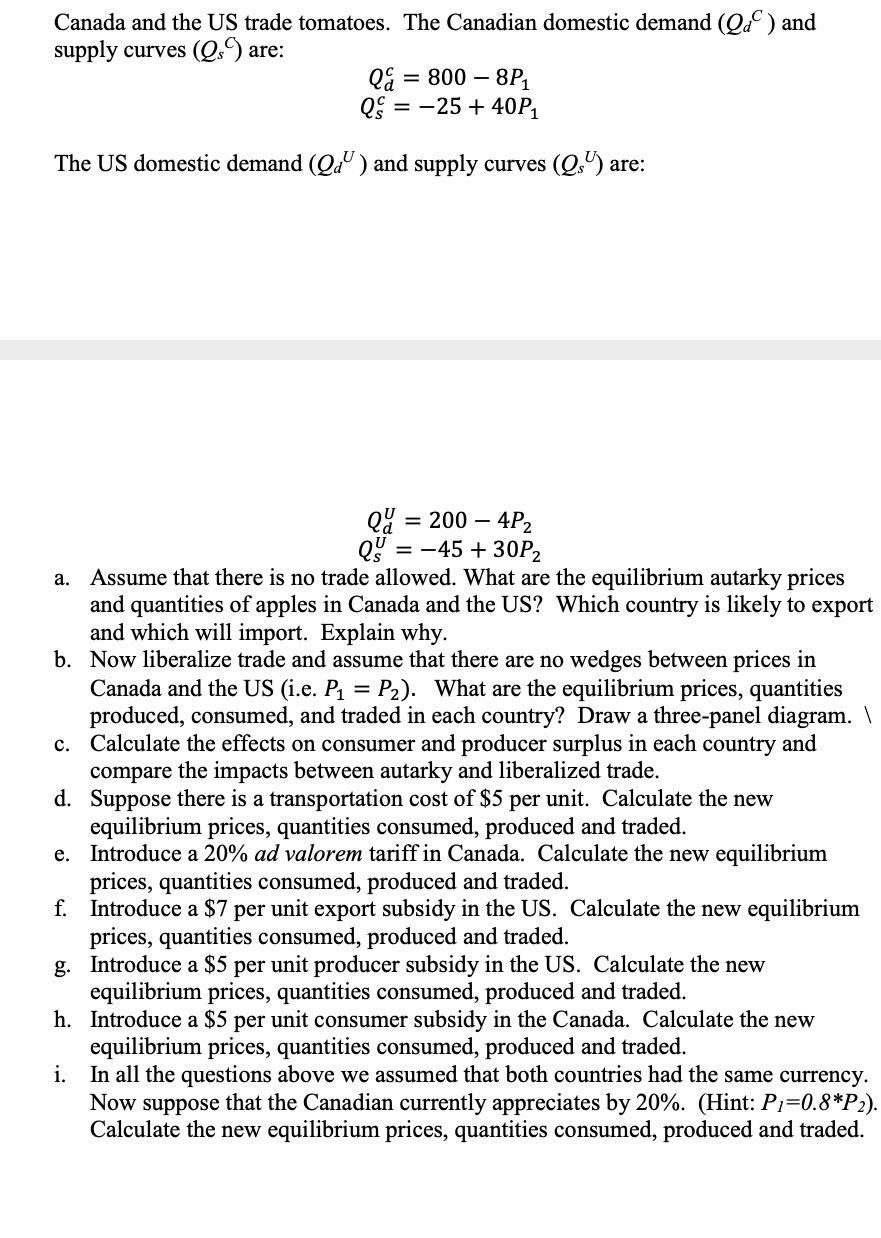
Canada and the US trade tomatoes. The Canadian domestic demand (Qc) and supply curves (Qs are: Qa = 800 - 8P Qs = -25 + 40P1 The US domestic demand (Qd') and supply curves (29) are: a. C. Q = 200 4P2 Q5 = -45 + 30P2 Assume that there is no trade allowed. What are the equilibrium autarky prices and quantities of apples in Canada and the US? Which country is likely to export and which will import. Explain why. b. Now liberalize trade and assume that there are no wedges between prices in Canada and the US (i.e. P1 = P2). What are the equilibrium prices, quantities produced, consumed, and traded in each country? Draw a three-panel diagram. \ Calculate the effects on consumer and producer surplus in each country and compare the impacts between autarky and liberalized trade. d. Suppose there is a transportation cost of $5 per unit. Calculate the new equilibrium prices, quantities consumed, produced and traded. e. Introduce a 20% ad valorem tariff in Canada. Calculate the new equilibrium prices, quantities consumed, produced and traded. f. Introduce a $7 per unit export subsidy in the US. Calculate the new equilibrium prices, quantities consumed, produced and traded. g. Introduce a $5 per unit producer subsidy in the US. Calculate the new equilibrium prices, quantities consumed, produced and traded. h. Introduce a $5 per unit consumer subsidy in the Canada. Calculate the new equilibrium prices, quantities consumed, produced and traded. i. In all the questions above we assumed that both countries had the same currency. Now suppose that the Canadian currently appreciates by 20%. (Hint: P1=0.8*P2). Calculate the new equilibrium prices, quantities consumed, produced and traded. Canada and the US trade tomatoes. The Canadian domestic demand (Qc) and supply curves (Qs are: Qa = 800 - 8P Qs = -25 + 40P1 The US domestic demand (Qd') and supply curves (29) are: a. C. Q = 200 4P2 Q5 = -45 + 30P2 Assume that there is no trade allowed. What are the equilibrium autarky prices and quantities of apples in Canada and the US? Which country is likely to export and which will import. Explain why. b. Now liberalize trade and assume that there are no wedges between prices in Canada and the US (i.e. P1 = P2). What are the equilibrium prices, quantities produced, consumed, and traded in each country? Draw a three-panel diagram. \ Calculate the effects on consumer and producer surplus in each country and compare the impacts between autarky and liberalized trade. d. Suppose there is a transportation cost of $5 per unit. Calculate the new equilibrium prices, quantities consumed, produced and traded. e. Introduce a 20% ad valorem tariff in Canada. Calculate the new equilibrium prices, quantities consumed, produced and traded. f. Introduce a $7 per unit export subsidy in the US. Calculate the new equilibrium prices, quantities consumed, produced and traded. g. Introduce a $5 per unit producer subsidy in the US. Calculate the new equilibrium prices, quantities consumed, produced and traded. h. Introduce a $5 per unit consumer subsidy in the Canada. Calculate the new equilibrium prices, quantities consumed, produced and traded. i. In all the questions above we assumed that both countries had the same currency. Now suppose that the Canadian currently appreciates by 20%. (Hint: P1=0.8*P2). Calculate the new equilibrium prices, quantities consumed, produced and traded







